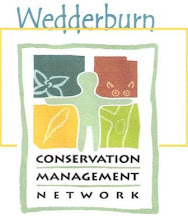 The Wedderburn Conservation Management Network has now been involved with the conservation of this endangered species since 2003. The malleefowl was selected as the iconic species for the Wedderburn CMN at the inception of the network and a great deal of time and effort has been put into the conservation of this isolated population of birds in the Wychitella Nature Conservation Reserve.
The Wedderburn Conservation Management Network has now been involved with the conservation of this endangered species since 2003. The malleefowl was selected as the iconic species for the Wedderburn CMN at the inception of the network and a great deal of time and effort has been put into the conservation of this isolated population of birds in the Wychitella Nature Conservation Reserve.The Camera Monitoring Project
This form of monitoring carried out in collaboration with Parks Vic, using non -invasive cameras mounted at an active mound is now in its second year and has proved to be successful in many ways. Peter Watts a member of the Wedderburn CMN and keen malleefowl conservationist has spent many hours over both seasons carrying out this work. At the beginning of the current breeding season new improved cameras, obtained through funding from Birds Australia, were located at the mound. After some time spent experimenting to optimise their performance these cameras have been used to observe such aspects as; the number of eggs laid, the hatching of chicks, visitors to the mound including predators and behavioural changes during the breeding season. Peter has found it possible to establish a predictive calendar of events which in turn makes for greater efficiency in observation. A short film of the breeding behaviour of the birds from last season has been made and used to increase community awareness of the endangered status of the birds. It is intended that a better quality film, using footage from the new cameras, be made for this purpose. A vast amount of film that may possibly be used for a more detailed study of mound behaviour has been archived.
Line Searches
The camera form of monitoring however does not give evidence as to the general wellbeing of the malleefowl population and other monitoring techniques have been employed to try to get an overall idea of trends in the population of the birds. One such important technique employed by the Wedderburn CMN in conjunction with the Victorian Malleefowl Recovery Group is that of line searches for malleefowl mounds. Such searches have located previously unknown mounds. Ideally, if all mounds were known and monitored on a regular basis then we would be in a much better position to understand the population dynamics of the birds. The Wedderburn CMN and partner organisations await the outcome of an application for funding made to Communities for Nature to assist in line searching. The establishment of an ongoing association with TAFE students has also helped greatly in these efforts and in the monitoring of browsers mentioned below.
Use of a helicopter
The latest technique under consideration is that of searching for mounds using a helicopter. Towards the end of last year a helicopter from the Department of Sustainability and the Environment was booked to make trial flights over selected parts of the Wychitella NCR. It had been arranged that two observers from the Wedderburn CMN would attempt mound sightings visually from onboard while the helicopter would also use its infrared equipment to attempt to locate mounds. Unfortunately this event has had to be postponed until later this year.
Vegetation transects
Vegetation transects including those over active and inactive mounds have been carried out to assess differential vegetation cover around malleefowl mounds. These have been completed and the collected data awaits the conclusion of analysis in an effort to understand better the habitat requirements of the birds.
Decommissioned eucy plantations
The latest exciting development has been that four eucalyptus oil harvesting coupes within the Wychitella NCR have been recently decommissioned. These blocks which occur in close proximity to areas known to be inhabited by malleefowl offer a great opportunity for possible expansion of malleefowl habitat providing such monocultures of mallee trees can be returned to a more naturally diverse species composition. The Wedderburn CMN have been monitoring a mature mallee thinning trial on a member’s property to determine whether opening up the canopy allows a more diverse understorey to develop. Results to date suggest that the understorey grows more vigorously, but the diversity of species isn’t obvious at this stage. It remains to be determined whether it will be sufficient to thin out the regrowth to allow natural regeneration of the understorey, or whether planting of more species is also needed. A visit to some of these sites has been arranged for the end of March to determine the best approach and whether the trials are a viable option for the group to pursue. Parks Victoria and DSE staff will accompany Wedderburn CMN members on this visit.
Concurrent ongoing efforts
Ongoing programs aimed at conservation of the birds have been proceeding alongside the efforts mentioned above. We have programs such as; an extensive fox baiting program, cat and rabbit control in areas within and surrounding the known habitat of the birds, monitoring of browsing competitors such as kangaroos and wallabies and successful efforts with respect to habitat expansion, linkage and enhancement.
Finally we will be seeking to obtain tax deductible gift status as an organization in an attempt to source further funding for our conservation work. Such status would be a financial encouragement for Corporate and Philanthropic organizations to contribute to the support of our work.
Article by Peter Watts, Wendy Murphy and Michael Moore

No comments:
Post a Comment